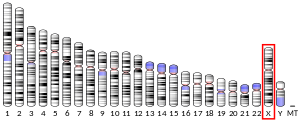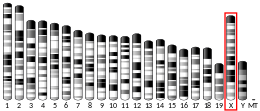60S ribosomal protein L10 is a protein that in humans is encoded by the RPL10 gene.[5][6]
Function
editRibosomes, the organelles that catalyze protein synthesis, consist of a small 40S subunit and a large 60S subunit. Together, these subunits are composed of 4 RNA species and approximately 80 structurally distinct proteins. This gene encodes a ribosomal protein that is a component of the 60S subunit. The protein belongs to the L10E family of ribosomal proteins. It is located in the cytoplasm. In vitro, studies have shown that the chicken protein can bind to c-Jun and can repress c-Jun-mediated transcriptional activation, but these activities have not been demonstrated in vivo. This gene was initially identified as a candidate for a Wilms tumor suppressor gene, but later studies determined that this gene is not involved in the suppression of Wilms tumor. This gene has been referred to as 'laminin receptor homolog' because a chimeric transcript consisting of sequence from this gene and sequence from the laminin receptor gene was isolated; however, it is not believed that this gene encodes a laminin receptor. Transcript variants utilizing alternative polyA signals exist. The variant with the longest 3' UTR overlaps the deoxyribonuclease I-like 1 gene on the opposite strand. This gene is co-transcribed with the small nucleolar RNA gene U70, which is located in its fifth intron. As is typical for genes encoding ribosomal proteins, there are multiple processed pseudogenes of this gene dispersed through the genome.[6]
Interactions
editReferences
edit- ^ a b c GRCh38: Ensembl release 89: ENSG00000147403 – Ensembl, May 2017
- ^ a b c GRCm38: Ensembl release 89: ENSMUSG00000008682 – Ensembl, May 2017
- ^ "Human PubMed Reference:". National Center for Biotechnology Information, U.S. National Library of Medicine.
- ^ "Mouse PubMed Reference:". National Center for Biotechnology Information, U.S. National Library of Medicine.
- ^ Kenmochi N, Kawaguchi T, Rozen S, Davis E, Goodman N, Hudson TJ, Tanaka T, Page DC (Aug 1998). "A map of 75 human ribosomal protein genes". Genome Res. 8 (5): 509–23. doi:10.1101/gr.8.5.509. PMID 9582194.
- ^ a b "Entrez Gene: RPL10 ribosomal protein L10".
- ^ Oh HS, Kwon H, Sun SK, Yang CH (September 2002). "QM, a putative tumor suppressor, regulates proto-oncogene c-yes". J. Biol. Chem. 277 (39): 36489–98. doi:10.1074/jbc.M201859200. PMID 12138090.
Further reading
edit- Wool IG, Chan YL, Glück A (1996). "Structure and evolution of mammalian ribosomal proteins". Biochem. Cell Biol. 73 (11–12): 933–47. doi:10.1139/o95-101. PMID 8722009.
- van den Ouweland AM, Kioschis P, Verdijk M, Tamanini F, Toniolo D, Poustka A, van Oost BA (1993). "Identification and characterization of a new gene in the human Xq28 region". Hum. Mol. Genet. 1 (4): 269–73. doi:10.1093/hmg/1.4.269. PMID 1303197.
- van den Ouweland AM, Verdijk M, Mannens MM, van Oost BA (1992). "The QM gene is X-linked and therefore not involved in suppression of tumorigenesis in Wilms' tumor". Hum. Genet. 90 (1–2): 144–6. doi:10.1007/bf00210759. PMID 1330878. S2CID 30349506.
- Kaneko K, Kobayashi H, Onodera O, Miyatake T, Tsuji S (1993). "Genomic organization of a cDNA (QM) demonstrating an altered mRNA level in nontumorigenic Wilms' microcell hybrid cells and its localization to Xq28". Hum. Mol. Genet. 1 (7): 529–33. doi:10.1093/hmg/1.7.529. PMID 1339145.
- Bignon C, Roux-Dosseto M, Zeigler ME, Wicha MS, Martin PM (1992). "cDNA cloning and genomic analysis of a new multigene family sharing common phylogenetic and expression profiles with the laminin receptor gene". Biochem. Biophys. Res. Commun. 184 (3): 1165–72. doi:10.1016/S0006-291X(05)80005-1. PMID 1534224.
- Dowdy SF, Lai KM, Weissman BE, Matsui Y, Hogan BL, Stanbridge EJ (1991). "The isolation and characterization of a novel cDNA demonstrating an altered mRNA level in nontumorigenic Wilms' microcell hybrid cells". Nucleic Acids Res. 19 (20): 5763–9. doi:10.1093/nar/19.20.5763. PMC 328988. PMID 1658743.
- Kato S, Sekine S, Oh SW, Kim NS, Umezawa Y, Abe N, Yokoyama-Kobayashi M, Aoki T (1995). "Construction of a human full-length cDNA bank". Gene. 150 (2): 243–50. doi:10.1016/0378-1119(94)90433-2. PMID 7821789.
- Matoba R, Okubo K, Hori N, Fukushima A, Matsubara K (1994). "The addition of 5'-coding information to a 3'-directed cDNA library improves analysis of gene expression". Gene. 146 (2): 199–207. doi:10.1016/0378-1119(94)90293-3. PMID 8076819.
- Maruyama K, Sugano S (1994). "Oligo-capping: a simple method to replace the cap structure of eukaryotic mRNAs with oligoribonucleotides". Gene. 138 (1–2): 171–4. doi:10.1016/0378-1119(94)90802-8. PMID 8125298.
- Farmer AA, Johnsen JI, Loftus TM, Smith KP, Stanbridge EJ (1996). "Isolation and characterization of the QM promoter". Nucleic Acids Res. 24 (11): 2158–65. doi:10.1093/nar/24.11.2158. PMC 145915. PMID 8668549.
- Chen EY, Zollo M, Mazzarella R, Ciccodicola A, Chen CN, Zuo L, Heiner C, Burough F, Repetto M, Schlessinger D, D'Urso M (1997). "Long-range sequence analysis in Xq28: thirteen known and six candidate genes in 219.4 kb of high GC DNA between the RCP/GCP and G6PD loci". Hum. Mol. Genet. 5 (5): 659–68. doi:10.1093/hmg/5.5.659. PMID 8733135.
- Chan YL, Diaz JJ, Denoroy L, Madjar JJ, Wool IG (1996). "The primary structure of rat ribosomal protein L10: relationship to a Jun-binding protein and to a putative Wilms' tumor suppressor". Biochem. Biophys. Res. Commun. 225 (3): 952–6. doi:10.1006/bbrc.1996.1277. PMID 8780716.
- Inada H, Mukai J, Matsushima S, Tanaka T (1997). "QM is a novel zinc-binding transcription regulatory protein: its binding to c-Jun is regulated by zinc ions and phosphorylation by protein kinase C". Biochem. Biophys. Res. Commun. 230 (2): 331–4. doi:10.1006/bbrc.1996.5955. PMID 9016777.
- Loftus TM, Nguyen YH, Stanbridge EJ (1997). "The QM protein associates with ribosomes in the rough endoplasmic reticulum". Biochemistry. 36 (27): 8224–30. doi:10.1021/bi970288d. PMID 9204867.
- Suzuki Y, Yoshitomo-Nakagawa K, Maruyama K, Suyama A, Sugano S (1997). "Construction and characterization of a full length-enriched and a 5'-end-enriched cDNA library". Gene. 200 (1–2): 149–56. doi:10.1016/S0378-1119(97)00411-3. PMID 9373149.
- Nguyen YH, Mills AA, Stanbridge EJ (1998). "Assembly of the QM protein onto the 60S ribosomal subunit occurs in the cytoplasm". J. Cell. Biochem. 68 (2): 281–5. doi:10.1002/(SICI)1097-4644(19980201)68:2<281::AID-JCB14>3.0.CO;2-I. PMID 9443083. S2CID 45083826.
- Hartley JL, Temple GF, Brasch MA (2001). "DNA Cloning Using In Vitro Site-Specific Recombination". Genome Res. 10 (11): 1788–95. doi:10.1101/gr.143000. PMC 310948. PMID 11076863.
- Simpson JC, Wellenreuther R, Poustka A, Pepperkok R, Wiemann S (2001). "Systematic subcellular localization of novel proteins identified by large-scale cDNA sequencing". EMBO Rep. 1 (3): 287–92. doi:10.1093/embo-reports/kvd058. PMC 1083732. PMID 11256614.



